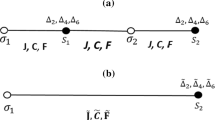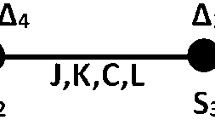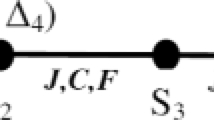Abstract
We have used the real-space Migdal-Kadanoff renormalization group technique on d-dimensional hypercubic lattice to study the mixed spin-1/2 and spin-2 Blume-Capel model. First, we indicate a critical dimension dC ≈ 2.05, above and below which different topologies of phase diagrams occur. The phase diagrams have been plotted in the (crystal field, temperature) plane around dC, in which there is a second-order phase transition. Moreover, using the variation of the free energy at low temperatures, we have established the ground-state phase diagrams in the (∆/J, C/J) plane for d < dC and d ≥ dC. In particular, we have seen the appearance of two first-order transitions at very low temperatures by the use of the free energy and its isotherm derivative. A detailed analysis of fixed points and flow diagrams indicates that there is no tricritical point.








Similar content being viewed by others
References
Kaneyoshi, T., Chen, J.C.: Mean-field analysis of a ferrimagnetic mixed spin system. J. Magn. Magn. Mater. 98, 201–204 (1991)
Plascak, J.A.: Multicritical points in the ferromagnetic binary Ising model. Physica A. 198, 655–665 (1993)
Bahmad, L., Benayad, M.R., Benyoussef, A., El Kenz, A.: The Effect of a Random Crystal-Field on the Mixed Ising Spins (1/2, 3/2). Acta Phys. Pol. A. 119, 740–746 (2011)
Hachem, N., Alehyane, M., Lafhal, A., Zahir, H., Madani, M., Alrajhi, A., El Bouziani, M.: Phase diagrams of the ferrimagnetic mixed spin-1/2 and spin-5/2 Ising model under a longitudinal magnetic field. Phys. Scr. 94, 025804 (2019)
Jaščur, M., Kaneyoshi, T.: A ferrimagnetic bilayer system in an applied transverse field. J. Phys. Condens. Matter. 5, 6313–6322 (1993)
Benyoussef, A., El Kenz, A., Kaneyoshi, T.: Diluted mixed spin-1 and spin- on honeycomb lattice. J. Magn. Magn. Mater. 131, 173–178 (1994)
Deviren, B., Keskin, M., Canko, O.: Magnetic properties of an anti-ferromagnetic and ferrimagnetic mixed spin-1/2 and spin-5/2 Ising model in the longitudinal magnetic field within the effective-field approximation. Physica A. 388, 1835–1848 (2009)
Buendía, G.M., Cardona, R.: Monte Carlo study of a mixed spin-3/2 and spin-1/2 Ising ferrimagnetic model. Phys. Rev. B. 59, 6784–6789 (1999)
Buendía, G.M., Hurtado, N.: Numerical Study of a Three-Dimensional Mixed Ising Ferrimagnet in the Presence of an External Field. Physica status solidi (b). 220, 959–967 (2000)
Zaim, A., Kerouad, M., Belmamoun, Y.: Monte Carlo study of a mixed spin- and spin-1 Blume-Capel ferrimagnetic model with four-spin interaction. Physica B. 404, 2280–2284 (2009)
Benayad, N.: Real-space renormalization group investigation of pure and disordered mixed spin Ising models ond-dimensional lattices. Z. Phys. B-Condens. Matter. 81, 99–105 (1990)
Quadros, S.G.A., Salinas, S.R.: Renormalization-group calculations for a mixed-spin Ising model. Physica A. 206, 479–496 (1994)
Bourass, M., Zradba, A., Zouhair, S., El Antari, A., El Bouziani, M., Madani, M., Alrajhi, A.: Real Space Renormalization Group Investigation of the Mixed Spins S = 1/2 and S = 3/2 Model. J. Supercond. Nov. Magn. 31, 541–546 (2018)
El Antari, A., Zahir, H., Hasnaoui, A., Hachem, N., Alrajhi, A., Madani, M., El Bouziani, M.: Mixed Spin-1/2 and Spin-5/2 Model by Renormalization Group Theory: Recursion Equations and Thermodynamic Study. Inter. J. Theor. Phys. 57, 2330–2342 (2018)
Kaneyoshi, T.: Tricritical behavior of a mixed spin- and spin-2 Ising system. Physica A. 205, 677–686 (1994)
Buendía, G.M., Liendo, J.A.: Monte Carlo simulation of a mixed spin 2 and spin Ising ferrimagnetic system. J. Phys. Condens. Matter. 9, 5439–5448 (1997)
Zahir, H., Bahlagui, T., El Kenz, A., El Bouziani, M., Benyoussef, A., Hasnaoui, A., Sbiaai, K.: Monte Carlo Study of the Mixed-Spin (1/2, 2) Ferrimagnetic Ising System on a Honeycomb Lattice. J. Supercond. Nov. Magn. 32, 963–970 (2019)
Albayrak, E., Yigit, A.: The critical behaviors and the phase diagram of the mixed spin-1/2 and spin-2 Ising system on the Bethe lattice. Physica status solidi (b). 242, 1510–1521 (2005)
Strečka, J.: Exact results of a mixed spin-1/2 and spin-S Ising model on a bathroom tile (4–8) lattice: Effect of uniaxial single-ion anisotropy. Physica A. 360, 379–390 (2006)
Li, J., Wei, G., Du, A.: Compensation phenomena of a mixed spin-2 and spin-1/2 Heisenberg ferrimagnetic model: Green function study. Physica B. 368, 121–130 (2005)
Zahir, H., Hasnaoui, A., Sbiaai, K., Lafhal, A., Hachem, N., Alrajhi, A., Madani, M., El Bouziani, M.: Random crystal-field effects in a mixed spin-1/2 and spin-2 ferrimagnetic Ising system. Chin. J. Phys. 56, 1949–1963 (2018)
Hoston, W., Berker, A.N.: Dimensionality effects on the multicritical phase diagrams of the Blume–Emery–Griffiths model with repulsive biquadratic coupling: Mean‐field and renormalization‐group studies. J. App. Phys. 70, 6101–6103 (1991)
Hoston, W., Berker, A.N.: Multicritical phase diagrams of the Blume-Emery-Griffiths model with repulsive biquadratic coupling. J. Phys. Rev. Lett. 67, 1027–1030 (1991)
Braga, G.A., Ferreira, S.J., Sá Barreto, F.C.: Upper bounds on the critical temperature for the two-dimensional Blume-Emery-Griffiths model. J. Stat. Phys. 76, 819–834 (1994)
Bakchich, A., El Bouziani, M.: Phase diagrams of the three-dimensional semi-infinite Blume-Emery-Griffiths model. Phys. Rev. B. 56, 11155–11160 (1997)
Atalay, B., Berker, A.N.: Lower lower-critical spin-glass dimension from quenched mixed-spatial-dimensional spin glasses. Phys. Rev. E. 98, 042125 (2018)
Migdal, A.A.: Phase transitions in gauge and spin-lattice systems. Zh. Eksp. Teor. Fiz. 69, 1457–1465 (1975).
Kadanoff, L.P.: Notes on Migdal's recursion formulas. Ann. Phys. 100, 359–394 (1976)
Blume, M.: Theory of the First-Order Magnetic Phase Change in UO2. Phys. Rev. 141, 517–524 (1966)
Capel, H.W.: On the possibility of first-order phase transitions in Ising systems of triplet ions with zero-field splitting. Physica. 32, 966–988 (1966)
Bakchich, A., Bassir, A., Benyoussef, A.: Phase transitions in the spin- Blume-Emery-Griffiths model. Physica A. 195, 188–196 (1993)
Hachem, N., Lafhal, A., Zahir, H., El Bouziani, M., Madani, M., Alrajhi, A.: The spin-2 Blume-Capel model by position space renormalization group. Superlatt. Microstr. 111, 927–937 (2017)
Nienhuis, B., Nauenberg, M.: First-Order Phase Transitions in Renormalization-Group Theory. Phys. Rev. Lett. 35, 477–479 (1975)
Lipowsky, R., Wagner, H.: The Migdal-Kadanoff renormalization group scheme for the Ising model with a free surface. Z. Phys. B-Condens. Matter. 42, 355–365 (1981)
Onsager, L.: Crystal Statistics. I. A Two-Dimensional Model with an Order-Disorder Transition. Phys. Rev. 65, 117–149 (1944)
Benayad, N., Zittartz, J.: Real-space renormalization group investigation of the three-dimensional semi-infinite mixed spin ising model. Z. Phys. B-Condens. Matter. 81, 107–112 (1990)
Yang, C.N.: The Spontaneous Magnetization of a Two-Dimensional Ising Model. Phys. Rev. 85, 808–816 (1952)
Lafhal, A., Hachem, N., Zahir, H., El Bouziani, M., Madani, M., Alrajhi, A.: Finite Temperature Phase Diagrams of the Mixed Spin-1 and Spin-2 Blume–Capel Model by Renormalization Group Approach. J. Stat. Phys. 174, 40–55 (2019)
Author information
Authors and Affiliations
Corresponding author
Additional information
Publisher’s Note
Springer Nature remains neutral with regard to jurisdictional claims in published maps and institutional affiliations.
Appendices
The Migdal-Kadanoff recursion equations (Eqs. 7)
We first replace the expression of Eq. (3) in the first side of Eq. (5) with σ1 = {±1/2} and S2 = {0, ±1 and ± 2}, which gives us ten forms. But considering that the cases (σ1, S2) and (−σ1, -S2) are equivalent, we only obtain five different forms \( {F}_{\sigma_1,{S}_2} \):
So according to Eq. (6), we get a system of six equations that gives us the interactions after decimation (Eq.6). By moving the potentials, we obtained the renormalized interactions (Eq. 7).
The invariant subspace J = C = 0
For J = C = 0, the following relations are obtained between the forms (9–12):
Therefore, we obtained: J ' = C ' = 0 (15).
Finally, we see that the subspace J = C = 0 is invariant by the transformation of the group (Eq. 7). The recursion equations in this subspace are written as follows:
The recursion eqs. (16) indicate that any positive value of Δ brings the system to Δ’ = +∞, but a negative value of Δ brings the system to Δ’ = -∞. We can also follow the same reasoning for Δ4. This gives us the following four fixed points: (0, 0, +∞, −∞), (0, 0, −∞, −∞), (0, 0, +∞, +∞) and (0, 0, −∞, +∞). Moreover, Δ = 0 lead to Δ’ = 0, and also Δ4 = 0 lead to Δ’4 = 0; thus we have the five fixed points: (0, 0, 0, +∞), (0, 0, 0, −∞), (0, 0, +∞, 0), (0, 0, −∞, 0) and (0, 0, 0, 0). Finally, we conclude that Eqs. (16) give us nine trivial fixed points.
-
The fixed point C*
At the fixed point C*, we have the following relations: J = -7C, Δ = +∞ and Δ4 = -∞, with |∆|˃˃|∆4|. From where:
where \( \tilde{x}=\frac{3\tilde{J}}{7} \) and \( x=\frac{3J}{7} \),
The division of (17) by (18) gives us:
-
For d = 2:
The renormalized interaction (x’ = bd-1.x̃) becomes (x’ = 3.x̃), and Eq. (19) is written as follows:
Since at the fixed point: x’ = x, we have:
We put \( y=\exp \left(\frac{4}{3}x\right) \), thus Eq. (21) becomes:
Eq. (22) has four solutions: \( y=\pm 1\ \mathrm{and}\ \frac{3\pm \sqrt{5}}{2} \), but since y > 0, the accepted solutions are: \( y=1\ \mathrm{and}\ \frac{3+\sqrt{5}}{2} \), and using the relations between y, x and J, we found \( J=0\ \mathrm{and}\ \frac{7}{4}\ln \left(\frac{3+\sqrt{5}}{2}\right) \). Finally, it is clear that the coordinates of point C* are: \( \left(\frac{7}{4}\ln \left[\frac{3+\sqrt{5}}{2}\right],-\frac{1}{4}\ln \left[\frac{3+\sqrt{5}}{2}\right],+\infty, -\infty \right) \) or (1.6842, −0.2406, +∞, −∞) representing the second-order ferromagnetic-paramagnetic transition. On the other hand, the point that has the coordinates: \( \left(\frac{7}{4}\ln \left[\frac{3-\sqrt{5}}{2}\right],-\frac{1}{4}\ln \left[\frac{3-\sqrt{5}}{2}\right],+\infty, -\infty \right) \) or (−1.6842, 0.2406, +∞, −∞) describes the second-order antiferromagnetic-paramagnetic transition.
-
For d = 3:
The renormalized interaction (x’ = bd-1.x̃) becomes (x’ = 9.x̃), and following the same steps as for d = 2, Eq. (19) is written in the form:
Eq. (23) gives us three solutions: x = ±0.17709560 and 0, and since we know that x = 3 J/7, the value of x that corresponds to C* is 0.17709560 and therefore the coordinates of point C* are: (0.4132, −0.0590, +∞, −∞) representing the second-order ferromagnetic-paramagnetic transition. Concerning the negative solution of x, it corresponds to second-order antiferromagnetic-paramagnetic transition; the coordinates of C* in this case are: (−0.4132, 0.0590, +∞, −∞).
Rights and permissions
About this article
Cite this article
Zahir, H., Hasnaoui, A., Aharrouch, R. et al. Dimensionality Effects on the Mixed Spin-1/2 and Spin-2 Blume-Capel Model: Renormalization Group Theory. Int J Theor Phys 60, 2856–2870 (2021). https://doi.org/10.1007/s10773-021-04869-y
Received:
Accepted:
Published:
Issue Date:
DOI: https://doi.org/10.1007/s10773-021-04869-y




